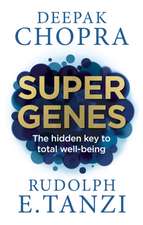Alzheimer's Disease: Advances in Genetics, Molecular and Cellular Biology
Editat de Sangram S. Sisodia, Rudolph E. Tanzien Limba Engleză Hardback – 28 dec 2006
| Toate formatele și edițiile | Preț | Express |
|---|---|---|
| Paperback (1) | 944.67 lei 6-8 săpt. | |
| Springer Us – 29 oct 2010 | 944.67 lei 6-8 săpt. | |
| Hardback (1) | 950.96 lei 6-8 săpt. | |
| Springer Us – 28 dec 2006 | 950.96 lei 6-8 săpt. |
Preț: 950.96 lei
Preț vechi: 1159.71 lei
-18% Nou
Puncte Express: 1426
Preț estimativ în valută:
181.99€ • 187.75$ • 154.03£
181.99€ • 187.75$ • 154.03£
Carte tipărită la comandă
Livrare economică 05-19 martie
Preluare comenzi: 021 569.72.76
Specificații
ISBN-13: 9780387351346
ISBN-10: 0387351345
Pagini: 286
Ilustrații: X, 286 p. 24 illus., 5 illus. in color.
Dimensiuni: 152 x 229 x 21 mm
Greutate: 0.6 kg
Ediția:2007
Editura: Springer Us
Colecția Springer
Locul publicării:New York, NY, United States
ISBN-10: 0387351345
Pagini: 286
Ilustrații: X, 286 p. 24 illus., 5 illus. in color.
Dimensiuni: 152 x 229 x 21 mm
Greutate: 0.6 kg
Ediția:2007
Editura: Springer Us
Colecția Springer
Locul publicării:New York, NY, United States
Public țintă
ResearchCuprins
The Genetics of Alzheimer’s Disease.- APP Biology, Processing and Function.- The Biology of the Presenilin Complexes.- ?-secretase: Physiological Role and Target Validation.- Cognitive Impairment in Transgenic A? and Tau Models of Alzheimer’s Disease.- Cholesterol and ?-Amyloid.- A? Structure and Aggregation.- Signaling Mechanisms that Mediate A? Induced Neuronal Dysfunction.- Beta Amyloid and Excitatory Synapses.- A? Degradation.- Role of A ? Transport and Clearance in the Pathogenesis and Treatment of Alzheimer’s Disease.- Tau Gene Mutations in FTDP-17 Syndromes.- Animal Models of Tauopathy.- Tau and Axonal Transport.- Growth Factors in Alzheimer’s Disease.
Textul de pe ultima copertă
Alzheimer’s Disease: Advances in Genetics, Cellular and Molecular Biology provides exciting, comprehensive and up-to-date summaries of the most important recent advances in the genetic, molecular, biochemical, and cell biological studies of AD. The studies and advances described in this volume will help to accelerate the process of rational drug discovery and soon serve to extend and enhance the mental health and lifespan of our burgeoning elderly population.
In 1906, Dr. Alois Alzheimer presented the case of his patient, Auguste D., a 51 year-old female admitted to the local asylum who presented with early memory impairments, psychoses, hallucinations and morbid jealousy. Dr. Alzheimer would argue that specific lesions that were present in and around neurons were responsible for dementia. In the ensuing decades, studies of the disorder that affected Auguste D., which would be named Alzheimer’s disease (AD), were largely limited to descriptive neuropathological and psychological assessments of this disease, but with little understanding of the molecular and cellular mechanisms underlying neurodegeneration and dementia.
This would change in the 1980s when the protein components of the major neuropathological hallmarks of the disease, senile plaques (and cerebral blood vessel amyloid) and neurofibrillary tangles were first determined. The identification of the ß-amyloid protein (Aß) and the microtubule-associated tau protein as the main components of plaques and tangles, respectively, would pave the way for the molecular genetic era of AD research. By the late-1980s, the genes encoding the ß-amyloid precursor protein (APP) and tau (MAPT) were identified and would subsequently be shown to harbor autosomal dominant mutations causing early-onset familial AD and frontal temporal dementia (FTD), respectively. In the early 1990s, the e4 variant of the apoliprotein E gene (APOE) would be found to beassociated with increased risk for late-onset AD. APP mutations increased the generation and subsequent deposition of the neurotoxic peptide, Aß42, in brain while APOE-e4 affected aggregation of Aß into fibrils and its clearance from brain. In 1995, genes encoding presenilin 1 and 2 (PSEN1, PSEN2) were identified, and mutations in MAPT were linked to frontal temporal dementia. Thus, by 1995, the stage was set for molecular studies of age-related dementias with APP, presenilin 1 and 2, APOE, and tau playing the major roles.
The vast majority of studies addressing the molecular mechanisms underlying dementia would continue to focus on characterizing the five genes already firmly implicated in the etiology and pathogenesis of these dementing disorders, and these efforts have provided a firm foundation for translational studies that will hopefully serve to take these findings from the bench top to the bedside designing and developing novel ways to diagnose, treat, and prevent these diseases.
In 1906, Dr. Alois Alzheimer presented the case of his patient, Auguste D., a 51 year-old female admitted to the local asylum who presented with early memory impairments, psychoses, hallucinations and morbid jealousy. Dr. Alzheimer would argue that specific lesions that were present in and around neurons were responsible for dementia. In the ensuing decades, studies of the disorder that affected Auguste D., which would be named Alzheimer’s disease (AD), were largely limited to descriptive neuropathological and psychological assessments of this disease, but with little understanding of the molecular and cellular mechanisms underlying neurodegeneration and dementia.
This would change in the 1980s when the protein components of the major neuropathological hallmarks of the disease, senile plaques (and cerebral blood vessel amyloid) and neurofibrillary tangles were first determined. The identification of the ß-amyloid protein (Aß) and the microtubule-associated tau protein as the main components of plaques and tangles, respectively, would pave the way for the molecular genetic era of AD research. By the late-1980s, the genes encoding the ß-amyloid precursor protein (APP) and tau (MAPT) were identified and would subsequently be shown to harbor autosomal dominant mutations causing early-onset familial AD and frontal temporal dementia (FTD), respectively. In the early 1990s, the e4 variant of the apoliprotein E gene (APOE) would be found to beassociated with increased risk for late-onset AD. APP mutations increased the generation and subsequent deposition of the neurotoxic peptide, Aß42, in brain while APOE-e4 affected aggregation of Aß into fibrils and its clearance from brain. In 1995, genes encoding presenilin 1 and 2 (PSEN1, PSEN2) were identified, and mutations in MAPT were linked to frontal temporal dementia. Thus, by 1995, the stage was set for molecular studies of age-related dementias with APP, presenilin 1 and 2, APOE, and tau playing the major roles.
The vast majority of studies addressing the molecular mechanisms underlying dementia would continue to focus on characterizing the five genes already firmly implicated in the etiology and pathogenesis of these dementing disorders, and these efforts have provided a firm foundation for translational studies that will hopefully serve to take these findings from the bench top to the bedside designing and developing novel ways to diagnose, treat, and prevent these diseases.
Caracteristici
There has been no scholarly research volume on Alzheimer’s Disease published in the last 3-5 years The editors are leaders in the field and have assembled many other leading researchers as contributors Includes supplementary material: sn.pub/extras







